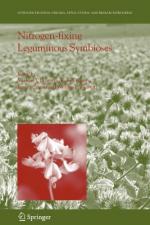|
This section contains 426 words (approx. 2 pages at 300 words per page) |

|
Nitrogen fixation is the biological process by which atmospheric nitrogen gas (N2) is converted into ammonia (NH3). Nitrogen is an essential nutrient for the growth of all organisms, as it is a component of proteins, nucleic acids, amino acids, and other cellular constituents. Nearly 79% of the earth's atmosphere is N2, but N2 is unavailable for use by most organisms, because it is nearly inert due to the triple bonds between the two nitrogen atoms. To utilize nitrogen, organisms require that it be fixed (combined) in the form of ammonium (NH4) or nitrate ions (NO3).
The bacteria that accomplish nitrogen fixation are either free-living or form symbiotic associations with plants or other organisms such as termites or protozoa. The free-living bacteria include both aerobic and anaerobic bacteria, including some species that are photosynthetic.
The most well-known nitrogen-fixing symbiotic relationships are those of legumes (e.g., peas, beans...
|
This section contains 426 words (approx. 2 pages at 300 words per page) |

|


